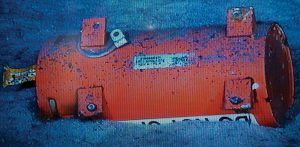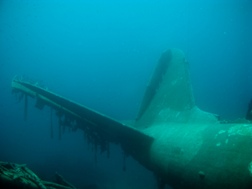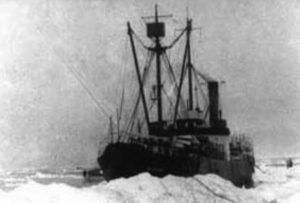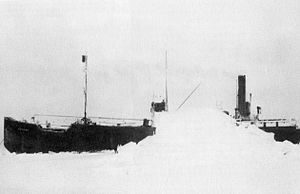captain
 On June 1, 2009, Air France Flight number 447 went down in the Atlantic Ocean. The flight took off from Rio de Janeiro on May 31, 2009.It was on it’s way to Paris, but nose-dived into the ocean long before reaching it’s destination. All 228 people on board were killed. A combination of bad weather, pilot error, and the captain’s extra-marital affair contributed to the deadliest crash in Air France history. Junior co-pilot Pierre-Cedric Bonin, 32, was piloting the Airbus A330 when it hit a thunderstorm over the sea. Bonin and fellow co-pilot David Robert, 37, pitched their craft sharply up instead of down, a fatal error that caused the plane to stall and and then pitch down, leading to the nose-dive into the ocean. Complicating the situation, Marc Dubois, the 58-year-old captain, had left the cockpit to take a nap, because he had been up all night with his mistress, and by the time he returned, it was too late to avoid catastrophe. Dubois had more than 11,000 flight hours compared to Bonin, who had logged a little less than 3,000.
On June 1, 2009, Air France Flight number 447 went down in the Atlantic Ocean. The flight took off from Rio de Janeiro on May 31, 2009.It was on it’s way to Paris, but nose-dived into the ocean long before reaching it’s destination. All 228 people on board were killed. A combination of bad weather, pilot error, and the captain’s extra-marital affair contributed to the deadliest crash in Air France history. Junior co-pilot Pierre-Cedric Bonin, 32, was piloting the Airbus A330 when it hit a thunderstorm over the sea. Bonin and fellow co-pilot David Robert, 37, pitched their craft sharply up instead of down, a fatal error that caused the plane to stall and and then pitch down, leading to the nose-dive into the ocean. Complicating the situation, Marc Dubois, the 58-year-old captain, had left the cockpit to take a nap, because he had been up all night with his mistress, and by the time he returned, it was too late to avoid catastrophe. Dubois had more than 11,000 flight hours compared to Bonin, who had logged a little less than 3,000.
Dubois and the rest of his crew had arrived in Rio three days before Flight 447’s departure. The probe’s lead  French investigator believes that the pilot, Dubois could have properly navigated the storm, but he was napping. “If the captain had stayed in position . . . it would have delayed his sleep by no more than 15 minutes, and because of his experience, maybe the story would have ended differently,” chief French investigator Alain Bouillard said. A search was quickly organized, but the plane sank to the ocean floor and wasn’t found for nearly two years. An oil slick thought to have been left by the downed Air France flight was spotted on June 3, 2009. Search and rescue was the toughest part in trying to solve the mystery of Flight 447’s disappearance over the Atlantic Ocean back on June 1st, 2009. Some wreckage was found a few days after the crash, but the probable cause couldn’t properly be determined until they found the black box, which took was about two years later. Of the bodies of the 228 passengers and crew, 74 remain lost in the water after the search
French investigator believes that the pilot, Dubois could have properly navigated the storm, but he was napping. “If the captain had stayed in position . . . it would have delayed his sleep by no more than 15 minutes, and because of his experience, maybe the story would have ended differently,” chief French investigator Alain Bouillard said. A search was quickly organized, but the plane sank to the ocean floor and wasn’t found for nearly two years. An oil slick thought to have been left by the downed Air France flight was spotted on June 3, 2009. Search and rescue was the toughest part in trying to solve the mystery of Flight 447’s disappearance over the Atlantic Ocean back on June 1st, 2009. Some wreckage was found a few days after the crash, but the probable cause couldn’t properly be determined until they found the black box, which took was about two years later. Of the bodies of the 228 passengers and crew, 74 remain lost in the water after the search  was finally called off.
was finally called off.
When the black box was finally found, the investigation into the crash could really begin. Flight 447 was going from Rio de Janeiro to Paris when it encountered a thunderstorm. It is now believed that the probable cause was a disconnect from autopilot due to ice crystals in the pitot tubes. With an aerodynamic stall, the crew couldn’t recover and eventually it led to the plane falling into the ocean. The inexperienced pilots did what most people would have in a stall, they pulled up. This only made the situation worse. By the time the experienced pilot got to the cockpit, it was too late to save the plane.
 Ghost ships have been a prominent tale of mystery over the years. Many say that seeing a ghost ship is an omen of doom, which I do not believe in, nor do I believe in ghosts or ghost ships, but there was a ship that was dubbed a ghost ship, and has had the longest standing as a possible ghost ship in history, at least to my knowledge. The SS Baychimo was a cargo ship that was built in 1914 in Sweden. It was used for trading routes between Hamburg and Sweden. After World War I, the ship was sold to the Hudson’s Bay Company. The ship made numerous sailings for Hudson’s, mostly carrying cargo to and from the Arctic region.
Ghost ships have been a prominent tale of mystery over the years. Many say that seeing a ghost ship is an omen of doom, which I do not believe in, nor do I believe in ghosts or ghost ships, but there was a ship that was dubbed a ghost ship, and has had the longest standing as a possible ghost ship in history, at least to my knowledge. The SS Baychimo was a cargo ship that was built in 1914 in Sweden. It was used for trading routes between Hamburg and Sweden. After World War I, the ship was sold to the Hudson’s Bay Company. The ship made numerous sailings for Hudson’s, mostly carrying cargo to and from the Arctic region.
The Baychimo had a lucrative career until October 1, 1931, when it was on a routine voyage, filled with recently acquired furs. An unexpected storm blew in, trapping the ship in a sea filled with ice. The closest city was Barrow, Alaska, the northern most city in the United States, and almost like being on top of the world, but it was too far to get to in the blowing snow and high winds. The captain and crew had to stay inside the trapped ship, where they hoped to wait out the storm. This storm was the beginning of the more bizarre part of Baychimo’s life.
When October 15th rolled around, the ship could still be found stuck in the ice, so 15 of the crew members were airlifted to safety. The captain and 14 other crew members made a temporary camp on the ice near the stranded ship…which turned out to be a very wise decision. The terrible weather continued to pound the crew and the “temporary” camp became home for weeks. Then, on November 24th, a fierce blizzard hit the area, and the snow was so heavy that the campers could no longer see the Baychimo, which was still trapped in the ice…or so they thought. The next morning, it was just as the expected. The ship had vanished. They assumed that it had been sunk by the preceding blizzard. The remaining crew made their way back to civilization.
Then, less than a week later, a hunter told the captain that the Baychimo could not have sunk, as he had just seen it floating in the icy waters almost fifty miles from the location where it had been abandoned. The captain was, understandably reluctant to battle the snows to try and find the ship, knowing that it could be miles for the last known location. Nevertheless, he gathered his crew and went looking. Just as the hunter had said, they found the Baychimo in the location the hunter had described. The ship looked like it was no longer seaworthy, so the captain didn’t think it would stay afloat much longer and would soon break apart and sink, so the crew gathered the cargo of furs and had everything, including the captain and the crew, airlifted out of the area.
The captain was wrong. The SS Baychimo was spotted again and again. In March of 1933, some Eskimos, trapped by a storm, took shelter in the Baychimo for a week until the weather improved enough to journey back to their homes. In November of 1939, another ship came close enough to the Baychimo that they were  able to board the abandoned ship, but due to the approaching ice floes, the captain did not have the time to bring it back to a port, although he did report the empty ship’s location. In 1969, the Baychimo was spotted at a distance, once again trapped in an ice pack. This was the last recorded sighting of the ship, and after a few years it was commonly believed that the ship did eventually give in to its deteriorating condition and sank to the bottom of the frigid seas. Not everyone agreed though, because in 2006, seventy-five years after the ship was first abandoned, the state of Alaska formally began an effort to find the mysterious SS Baychimo, the Arctic’s elusive wandering ship.
able to board the abandoned ship, but due to the approaching ice floes, the captain did not have the time to bring it back to a port, although he did report the empty ship’s location. In 1969, the Baychimo was spotted at a distance, once again trapped in an ice pack. This was the last recorded sighting of the ship, and after a few years it was commonly believed that the ship did eventually give in to its deteriorating condition and sank to the bottom of the frigid seas. Not everyone agreed though, because in 2006, seventy-five years after the ship was first abandoned, the state of Alaska formally began an effort to find the mysterious SS Baychimo, the Arctic’s elusive wandering ship.

